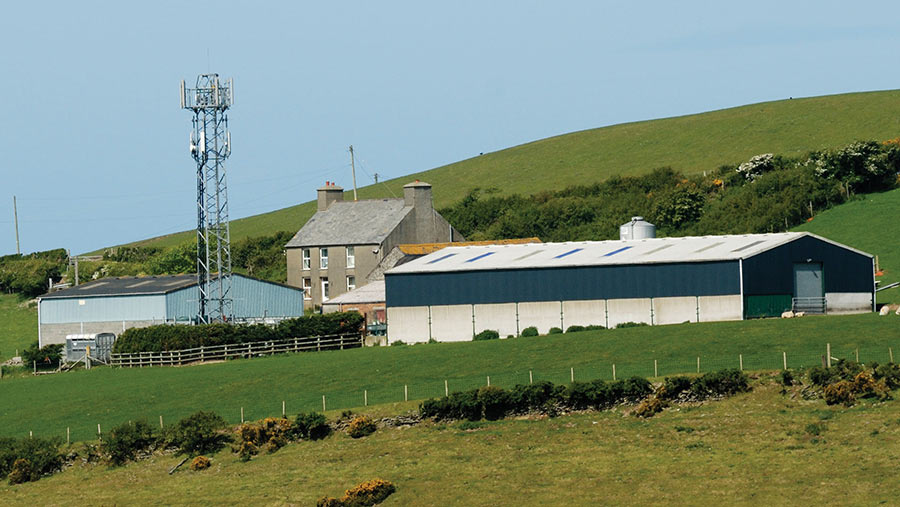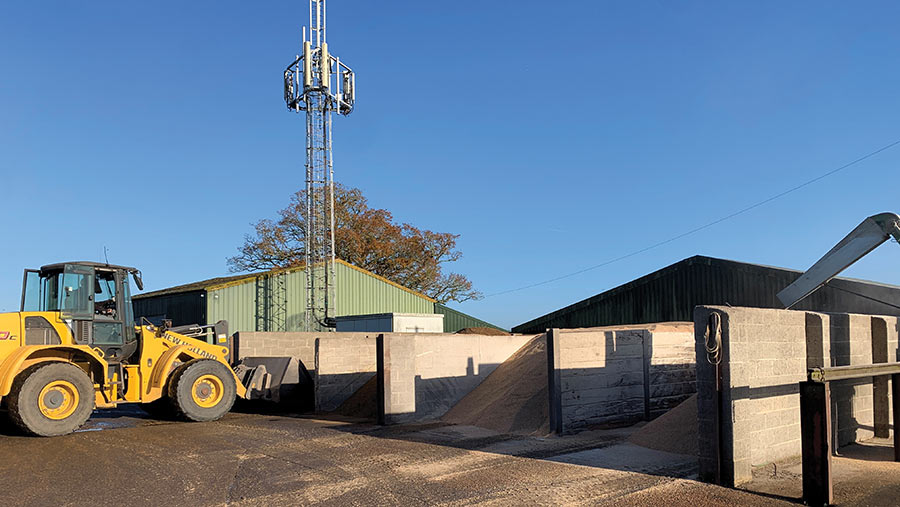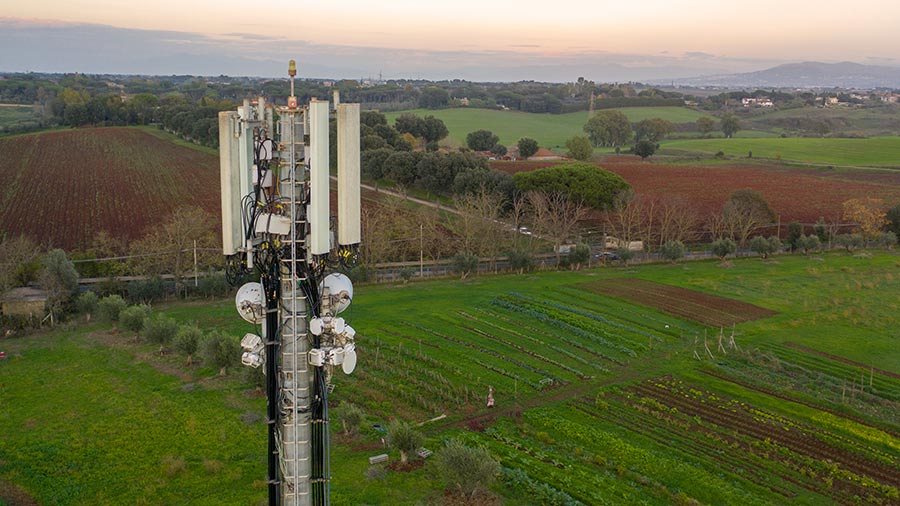How legislation affects rural telecoms mast landlords
 © KBImages/Alamy Stock Photo
© KBImages/Alamy Stock Photo Rents for telecommunications masts have been under downward pressure for about five years, with this and other aspects making many rural landlords far less willing to renew leases or offer new sites.
While an original agreement might typically have been at a rent of between £5,000 and £7,000/year for a rural mast site, renewals are being offered at just £1,000-£1,500.
Rural mast rent cases that go to court are being awarded at between £750 and £1,200, as a result of the valuation method applied under the 2017 Electronic Communications Code, based on the alternative use value of the land.
See also: A guide to reclaiming professional fees paid by farmers
The political and market imperatives to expand and upgrade telecommunications of many types mean recent legislation largely puts mast landlords in a weaker position.
The Product Security and Telecommunications Infrastructure Act 2022 (PSTIA) came into force on 6 December 2022, with many of its provisions being introduced in stages.
The act makes several changes to the Electronic Communications Code, which governs the relationship between landowners and the operators of cables or masts.
Telecoms partner Tom Bodley-Scott, at land agent Batcheller Monkhouse, says several aspects of the PSTIA are already having an effect on the ground, and mast landlords might want to consider action in anticipation of changes yet to be introduced.

© Batcheller Monkhouse
Alternative dispute resolution
Parts that are in force include the use of alternative dispute resolution (ADR).
“This imposes a duty on operators to consider the use of ADR to resolve or narrow down disputes before making an application to the court,” says Tom.
“Unreasonable refusal to engage with ADR by either party could have an impact on costs when these are awarded if the case ends up in court.
“ADR ought to enable farmers to have a faster and cheaper method of resolving disputes with operators.
“If using a surveyor in a straightforward ADR mast case, it should be possible to keep the landowner’s costs in the region of £3,000, but ADR could cost £10,000 or more for each side when other professionals are also used or needed.”
While ADR is, in theory, the simpler and cheaper approach, it is not unknown for the mast operator to attend mediation meetings accompanied by a large legal team, including barristers, which can be intimidating for the landowner party.
The court route is through the Upper Tribunal of the Lands Chamber, where barristers are needed, pushing costs even for a simple case into the £50,000-£80,000 range for each party, says Tom, with others going over £100,000.
However, more than 400 cases have gone to tribunal under the 2017 code, compared with just a handful under its predecessor.
Telecoms lease market
Operators are not getting the volume of agreement renewals completed as they had hoped, says Batcheller Monkhouse, which advises more than 800 mast site owners – about half of which are rural.
As a result, some operators are offering greater carrots to encourage farmers to accept their demands, including slightly higher rents or other financial incentives.
Those incentives might be a one-off payment of up to £5,000 if the case is pushed hard, or for the rent to be reduced from existing levels in steps over several years.
However, the threat of litigation as part of a renewal is always in the background, warns Tom Bodley-Scott.
Farmers cannot refuse to have a telecommunications mast on their land, as operators have compulsory access rights.
Despite relatively strong demand for new sites, rents for these are at a similar rate as for code renewals, albeit that landlords would also expect to obtain a one-off payment for the disturbance associated with creation of a new site, which for a typical single mast site would range from £2,000 to £5,000.
Rights to upgrade and share apparatus
Operators’ rights to upgrade and share apparatus are also extended under the PSTIA.
“This means that more contractors will want to cross farmers’ land to get to masts, often leading to greater disturbance and damage to property or operations.”
Some sites are shared by three or more operators, which will have varying needs for frequency of access.
“Any extra money paid to the farmer [under an original agreement] for allowing the site to be shared will stop under the code, and any conditions limiting upgrading will become void.”
For example, a mast lease at an original rent of £5,000 might typically have included sharing rights, with the leaseholder passing on to the landlord say 30% of the additional income they receive from a party with which they share the mast. Such payments will now cease.
The landlord is entitled to compensation for damage caused by operators or site sharers – for example, damage to fences, other boundaries and land, or as a result of gates being left open.
Site users must also pay the landlord’s professional costs associated with such a claim.
Removal or relocation of masts
There has been a significant increase in the number of farmers seeking advice on how to remove or relocate masts from fields and yards, says Tom Bodley-Scott.
“Perhaps while a higher consensual rent was being paid, farmers were happy to let matters lie.
“However, with rents falling and farm businesses changing, farmers are now bringing forward plans to redevelop parts of their land or adjoining land and find that they cannot do so unless the mast is removed.
“Provided that the intent to develop is genuine and the motive sound, the farmer ought to be able to resist the renewal or to seek to end the agreement and subsequently get the operator to remove its mast at the operator’s cost.”
This can be a complex and prolonged process where advice is recommended – the operator may want to relocate the mast to another part of the property, which is a right they are often able to exercise.
There are very limited grounds for refusing to site or relocate a mast.

© Stefano Tammaro/Adobe Stock
Interim arrangements pending code rights
After a lease renewal under the code is formally requested, operators can now apply for an interim order seeking to stop payment of the existing [high] rent and replacing it with the lower rent sooner than the renewal date.
“This is something the operators can use as a backstop, but has not yet been much used,” says Tom.
“However, it will still be open to the parties to agree that the farmer continues to receive the passing [existing] rent or agree an alternative amount as part of the discussions for a consensual agreement.”
Legal notices from operators’ lawyers typically offer renewal rents of £750-£1,200/year for rural masts.
However, in many cases it is possible to negotiate slightly better rental packages of about £2,000, says Tom.
If the site has an alternative use value higher than agricultural value, the rent should be higher.
Leases under Landlord and Tenant Act 1954
Another part of the PSTIA, yet to be implemented, will amend valuations under the Landlord and Tenant Act 1954 (LTA 1954), under which Tom estimates about 60-70% of rural mast sites are leased.
This change will mean valuations aligning to code valuations.
“This will reduce rents for LTA 1954 leases from perhaps £2,000-£3,000/year to about £1,500 – something welcomed by code operators, but regarded by farmers as yet another aggressive stance and a further unwelcome and unjustified erosion of the value of telecoms leases,” says Tom.
However, this will not come into force until further transitional provisions have been passed, possibly later this year.
“If a renewal notice has already been served, farmers with 1954 Act telecoms leases would be well advised to progress current renewals as quickly as possible to avoid the possibility of the forthcoming change in valuation methodology applying to the renewal,” advises Tom.
Advice for farmers
- Farmers with Landlord and Tenant Act 1954 mast leases and where the renewal process has begun (that is, notice has been served) should progress renewals as quickly as possible. This will avoid the possibility of the forthcoming change in valuation methodology applying to the renewal and leading to a larger drop in rent than they might otherwise be able to negotiate.
- Where an agreement ended two or three years ago and the site operator has not made an approach for a renewal, it is worth site landowners considering keeping their heads down and continuing to collect the old rent. On the other hand, when the operator does approach for a renewal, landlords should not delay, because once a notice is served, costs can escalate if landlords are unresponsive.
- Most mast lease agreements will include a “making good” damage clause. However, check existing agreements and any new ones being considered for “damage not foreseen” clauses. For example, unforeseen damage might include where an operator’s site work overruns and the farm business or a seasonal diversification suffer loss as a result of the overrun.
Source: Tom Bodley-Scott, head of telecoms, Batcheller Monkhouse
